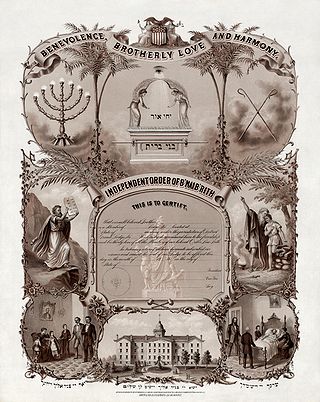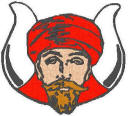Related Research Articles

B'nai B'rith International is a Jewish service organization. B'nai B'rith states that it is committed to the security and continuity of the Jewish people and the State of Israel and combating antisemitism and other forms of bigotry.

The Workers Circle or Der Arbeter Ring, formerly The Workmen's Circle, is an American Jewish nonprofit organization that promotes social and economic justice, Jewish community and education, including Yiddish studies, and Ashkenazic culture. It operates schools and Yiddish education programs, and year-round programs of concerts, lectures and secular holiday celebrations. The organization has community branch offices throughout North America, a national headquarters in New York City and approximately 11,000 members nationwide. It owns and operates a summer camp located in Hopewell Junction, New York called Camp Kinder Ring. It also runs an adult vacation campground facility, Circle Lodge, with bungalows and cottages, and a healthcare center in Bronx, New York.

The Independent Order of Odd Fellows (IOOF) is a non-political and non-sectarian international fraternal order of Odd Fellowship. It was founded in 1819 by Thomas Wildey in Baltimore, Maryland, United States. Evolving from the Order of Odd Fellows founded in England during the 18th century, the IOOF was originally chartered by the Independent Order of Oddfellows Manchester Unity in England but has operated as an independent organization since 1842, although it maintains an inter-fraternal relationship with the English Order. The order is also known as the Triple Link Fraternity, referring to the order's "Triple Links" symbol, alluding to its motto "Friendship, Love and Truth".

The Fraternal Order of Police (FOP) is a fraternal organization consisting of sworn law enforcement officers in the United States. It reports a membership of over 355,000 members organized in 2,100 local chapters (lodges), state lodges, and the national Grand Lodge. The organization attempts to improve the working conditions of law enforcement officers and the safety of those they serve through education, legislation, information, community involvement, and employee representation.
The Slovene National Benefit Society, known in Slovenian as Slovenska narodna podporna jednota, and by its Slovene initials S.N.P.J. is an ethnic fraternal benefit and social organization for Slovene immigrants and their descendants in the United States. Founded in 1904, it is headquartered in suburban Pittsburgh, Pennsylvania, USA near Imperial. SNPJ publishes a newspaper, Prosveta.

B'nai Brith Canada is a Canadian Jewish service organization and advocacy group. It is the Canadian chapter of B'nai B'rith International.

The history of the Jews in Ukraine dates back over a thousand years; Jewish communities have existed in the modern territory of Ukraine from the time of the Kievan Rus'. Important Jewish religious and cultural movements, from Hasidism to Zionism, arose there. According to the World Jewish Congress, the Jewish community in Ukraine constitutes Europe's third-largest and the world's fifth-largest.

The Mystic Order of Veiled Prophets of the Enchanted Realm, also known as M.O.V.P.E.R. or The Grotto, after its lodge equivalent, is an appendant body in Freemasonry.
The Temple - Congregation Adath Israel Brith Sholom is a Reform synagogue located in Louisville, Kentucky. Originally the Adath Israel Temple, it adopted its current name following a merger, but is more commonly known by the informal name The Temple. Prior to merging, the congregations resided in several buildings, with the Adath Israel Temple's third synagogue listed on the National Register of Historic Places.

Mayer Sulzberger was an American judge and Jewish communal leader.

The Order of the Sons of Hermann (German: Der Orden der Hermanns-Soehne, also known as Hermann Sons, is a mutual aid society for German immigrants that was formed in New York, New York on July 20, 1840, and remains active in the states of California, Ohio, and Texas today. Open to members of any heritage today, the order provides low-cost insurance and mutual aid and has historically promoted the preservation of the German language and traditions.

Congregation Beth Jacob Ohev Sholom is an Orthodox synagogue located at 284 Rodney Street in Williamsburg, Brooklyn, New York. It is the oldest Orthodox congregation on Long Island, and one of the last remaining non-Hasidic Jewish institutions in Williamsburg.
Danish Brotherhood in America is a fraternal organization that was founded in 1882 in Omaha, Nebraska. It had about 8,000 members in 2010. A period report said of the Danish Brotherhood, "This is by far the strongest and most influential secular organization about the Danes in America."

Bundism was a secular Jewish socialist movement whose organizational manifestation was the General Jewish Labour Bund in Lithuania, Belarus, Poland, and Russia, founded in the Russian Empire in 1897.
The Jewish Big Sisters was a communal organization offering support to Jewish children arraigned in the Children's Courts of New York City. Established in 1912, it was an outgrowth of the Big Brothers Big Sisters movement which sought to provide mentorship to boys who had gone through the Children's Courts. As more Jewish boys and girls found their way into the court system, support materialized for the formation of organizations first for boys and then for girls with the aim of preventing delinquency.
Rabbi Bernard Louis Levinthal, the "Dean of U. S. Rabbis," built Philadelphia's first Eastern European Orthodox Jewish community from his arrival in the United States in 1891 until his death in 1952. Rabbi Levinthal helped found American Jewish Orthodox institutions including Yeshiva University in 1896, the Orthodox Union in 1898, Mizrachi in 1902, and the American Agudas Harabbanim. His grave is in Congregation Mikveh Israel's 55th Street Cemetery in West Philadelphia.
Israel Edwin Goldwasser was a Jewish-American teacher, principal, philanthropist, and businessman from New York.

Henrietta Bruckman was founder of the first fraternal organization for Jewish women in the United States.